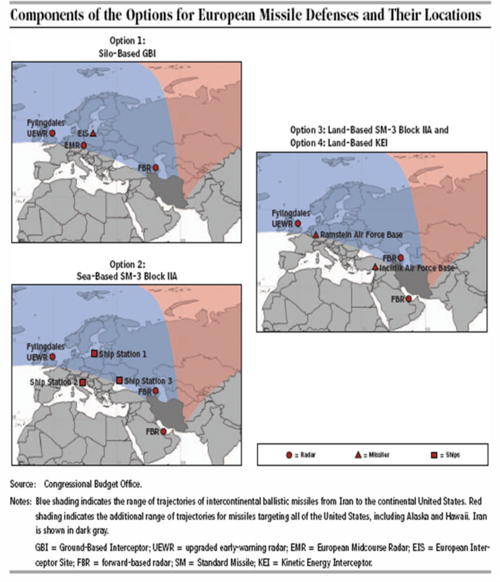European ballistic missile defense: Difference between revisions
imported>Howard C. Berkowitz |
imported>Howard C. Berkowitz |
||
| Line 24: | Line 24: | ||
1,500-3,437 mi | 1,500-3,437 mi | ||
| Israeli [[Jericho III]],<br /> | | Israeli [[Jericho III]],<br /> | ||
North Korean [[Nodong B]]; Iranian [[Shahab 3B]] derivative | North Korean [[Nodong B]]; Iranian [[Shahab 3B]] derivative,<br /> | ||
Chinese [[DF-4]] | Chinese [[DF-4]] | ||
|- | |- | ||
| Line 37: | Line 37: | ||
|} | |} | ||
§submarine launched | §submarine launched | ||
The Shahab 3B may not yet be operational; the Taepo Dong 2 has performed badly in tests. | |||
{| class="wikitable" | {| class="wikitable" | ||
Revision as of 15:13, 10 October 2009
Ballistic missile defense, in the post-Cold War era, is increasingly an issue for Europe. The primary concern is no longer the Soviet Union, but Iran and possibly other Middle Eastern actors. While Russia theoretically is a threat, it is not a likely one.
Russsia, however, became indignant over what it saw as U.S. action in its sphere of influence, when the George W. Bush Administration proposed placing Ground-Based Midcourse Interceptors in Poland. While much mass media coverage portrayed this as a shield against attacks against Eastern Europe, the particular technology proposed actually was optimized for protecting the East coast of the United States against intercontinental ballistic missiles.
On 17 September 2009, the Obama administration withdrew the earlier proposal, in part because it could not be implemented for several years, and really did not address the short-term Iranian threat of intermediate-range ballistic missiles. An alternative approach can be deployed in a year, at lower cost. It has been proposed that the system be implemented as a European multilateral defense, rather than bilateral agreements with the U.S.
Review of threats
| Type | Range | Examples |
|---|---|---|
| medium range ballistic missile
(MRBM) |
800-2,399 km
500-1499 mi |
Iranian Shahab 3, Israeli Jericho II |
| intermediate range ballistic missile
(IRBM) |
1,400-5,499 km
1,500-3,437 mi |
Israeli Jericho III, North Korean Nodong B; Iranian Shahab 3B derivative, |
| intercontinental ballistic missile
(ICBM) |
+ 5,500 km
+ 3,438 mi |
Chinese DF-5, North Korean Taepo Dong 2, |
§submarine launched
The Shahab 3B may not yet be operational; the Taepo Dong 2 has performed badly in tests.
| Point of launch | Point of impact | Range |
|---|---|---|
| Teheran | Warsaw | 3020 kilometers
1876 miles |
| London | 4408 kilometers
2739 miles | |
| Washington, DC | 10,201 kilometers
6339 miles |
Review of components
Initial proposals
In this illustration from the Congressional Budget Office, the systems shown are principally European-based components for engaging ICBMs aimed at the United States. The initial Bush administration proposal was silo-based GBI, option 1, which is midcourse-intercept-only and could not provide terminal defense of a target in Europe, except possibly in a very limited engagement geometry This proposal also assumed ten interceptor missiles, with two fired at each incoming ICBM, so six Iranian missiles could saturate the system even under fairly optimal assumptions.
Current warships that fire SM-3 have between 96 and 120 launch tubes, although all might not be filled with SM-3's; it would be prudent to give the ship some SM-2 and ESSM anti-aircraft missiles for self-defense. These could engage incoming IRBMs.
Option 3 assumes the SM-3 missiles are on land, which is not a major technological effort, but also includes a not-yet-operational KEI.
